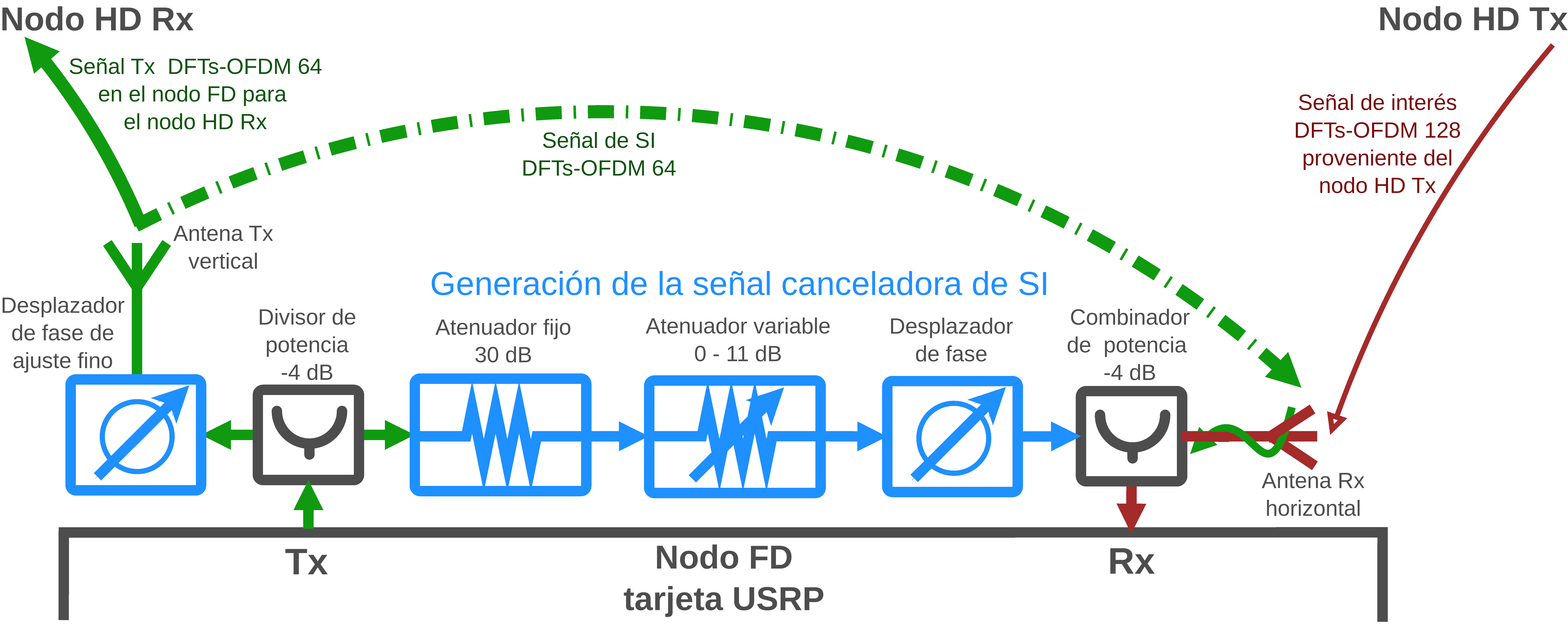Self Interference Cancellation on a Full Duplex DFTs-OFDM System using GNU Radio and USRP
Keywords:
FD, SIC, GNU Radio, USRP, OFDM, DFTsAbstract
The physical layer of an orthogonal frequency division multiplexing (OFDM) wireless communication system, operating in full-duplex (FD) mode is implemented in this paper, using GNU Radio software and universal software radio peripheral (USRP) hardware technology. The self-interference cancellation (SIC) is achieved on the FD node by applying four different techniques, two in the radio frequency (RF) domain and two in the digital domain. In the RF domain, a passive suppression is obtained by placing the transmit (Tx) and the receive (Rx) antennas such that they generate orthogonal electromagnetic fields. Also, an active signal suppression is achieved by changing the phase and attenuating the self-interference (SI) Tx signal, to generate a local SIC signal. The SIC signal and the Rx signal are then combined before going to the low noise amplifier at the FD node. In the digital domain, two techniques are applied to improve the interference cancellation and the quality of the link: firstly, virtual differentiation of the Tx and Rx signals is achieved by using OFDM symbols with different sizes; secondly, a spreading and precoding technique utilizing the discrete Fourier transform (DFT) is considered. In order to test the practical operation of the FD node, two simultaneous links between the three nodes are established. The results of the implemented system show that the SI can be reduced up to 58 dB which, along with the two digital techniques, allows to have two simultaneous links with a bit error rate similar to the one achieved with just one link without interference, increasing the spectral efficiency.
Downloads
References
B. Debaillie, B. van Liempd, B. Hershberg, J. Craninckx, K. Rikkinen, D. J. van den Broek, E. A. M. Klumperink, and B. Nauta, “In-band full-duplex transceiver technology for 5g mobile networks,” in ESSCIRC Conference 2015 - 41st European Solid-State Circuits Conference (ESSCIRC), 2015, pp. 84–87.
A. Sabharwal, P. Schniter, D. Guo, D. W. Bliss, S. Rangarajan, and R. Wichman, “In-band full-duplex wireless: Challenges and opportunities,” IEEE Journal on Selected Areas in Communications, vol. 32, no. 9, pp. 1637–1652, 2014.
M. Duarte, “Full-duplex wireless: Design, implementation and characterization,” Ph.D. dissertation, Rice University, 2012
L. Irio and R. Oliveira, “Distribution of the residual self-interference power in in-band full-duplex wireless systems,” IEEE Access, vol. 7, pp. 57 516–57 526, 2019.
D. Bharadia, E. McMilin, and S. Katti, “Full duplex radios,” SIGCOMM Comput. Commun. Rev., vol. 43, no. 4, p. 375–386, Aug. 2013. [Online]. Available: https://doi.org/10.1145/2534169.2486033
W. Zhou, G. Villemaud, and T. Risset, “Full duplex prototype of ofdm on gnuradio and usrps,” in 2014 IEEE Radio and Wireless Symposium (RWS), 2014, pp. 217–219.
M. Duarte, A. Sabharwal, V. Aggarwal, R. Jana, K. K. Rama krishnan, C. W. Rice, and N. K. Shankaranarayanan, “Design and characterization of a full-duplex ultiantenna system for wifi networks,” IEEE Transactions on Vehicular Technology, vol. 63, no. 3, pp. 1160–1177, 2014.
A. Nagulu, T. Chen, G. Zussman, and H. Krishnaswamy, “A full-duplex radio using a cmos non-magnetic circulator achieving +95 db overall sic,” in 2019 USNC-URSI Radio Science Meeting (Joint with AP-S Symposium), 2019, pp. 71–72.
M. S. Amjad, H. Nawaz, K. Özsoy, O. Gürbüz, and I. Tekin, “A low-complexity full-duplex radio implementation with a single antenna,” IEEE Transactions on Vehicular Technology, vol. 67, no. 3, pp. 2206–2218, 2018.
T. M. Schmidl and D. C. Cox, “Robust frequency and timing synchronization for ofdm,” IEEE Transactions on Communications, vol. 45, no. 12, pp. 1613–1621, 1997.
A. Ben-israel and T. N. E. Greville, “Generalized inverses: Theory and applications,” 2001.
S. Haykin, Adaptive Filter Theory (3rd Ed.). USA: Prentice Hall, Inc., 1996.
Radio. Gnu radio manual. [Online]. Available: https://www.gnuradio.org/doc/doxygen3.7.3/ofdm__frame__equalizer__vcvc_8h_source.html
S. Radio. Gnu radio manual. [Online]. Available: https://www.gnuradio.org/doc/doxygen/classgr_1_1digital_1_1lms__dd__equalizer__cc.htmldetails
A. Sahin, E. Bala, R. Yang, and R. L. Olesen, “Dft-spread ofdm with frequency domain reference symbols,” in GLOBECOM 2017 - 2017 IEEE Global Communications Conference, 2017.
F. Adachi and A. Boonkajay, “Frequency-domain based single-carrier waveform design through precoder,” in 2014 IEEE International Conference on Communication Systems, 2014, pp. 207–211.
F. S. Foundation. Gnu radio main page. [Online]. Available: https://wiki.gnuradio.org/index.php/Main_Page
NI. About ettus research. [Online]. Available: https://www.ettus.com/about/
Y. Li, “Blind snr estimation of ofdm signals,” in 2010 International Conference on Microwave and Millimeter Wave Technology, 2010, pp. 1792–1796.
NI. Usrp b210. [Online]. Available: https://www.ettus.com/wpcontent/uploads/2019/01/b200-b210_spec_sheet.pdf
M. V. Gonzaga Ferreira and F. H. Teles Vieira, “Resource allocation in f-ofdm wireless networks with delay estimation using service curve and envelope process,” IEEE Latin America Transactions, vol. 18, no. 07, pp. 1222–1229, 2020.


